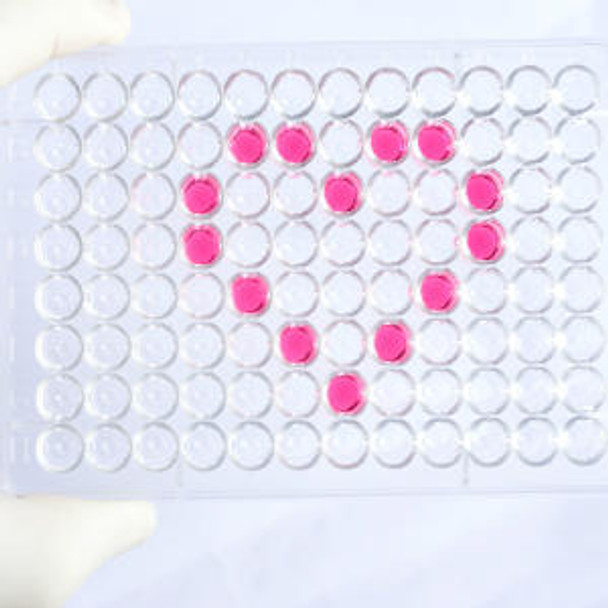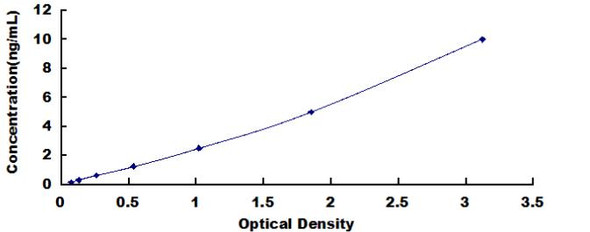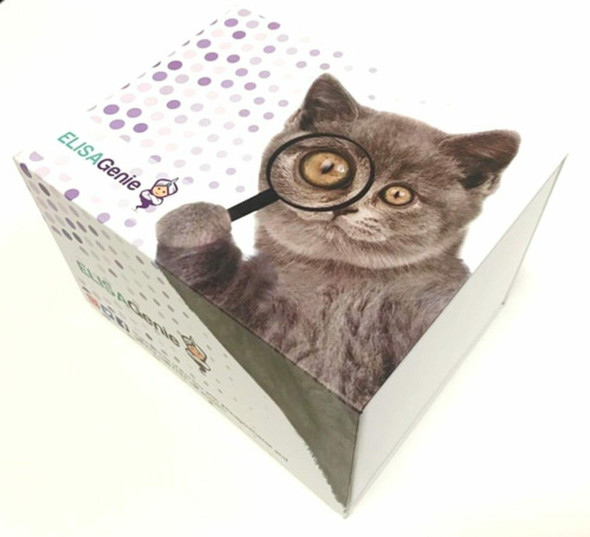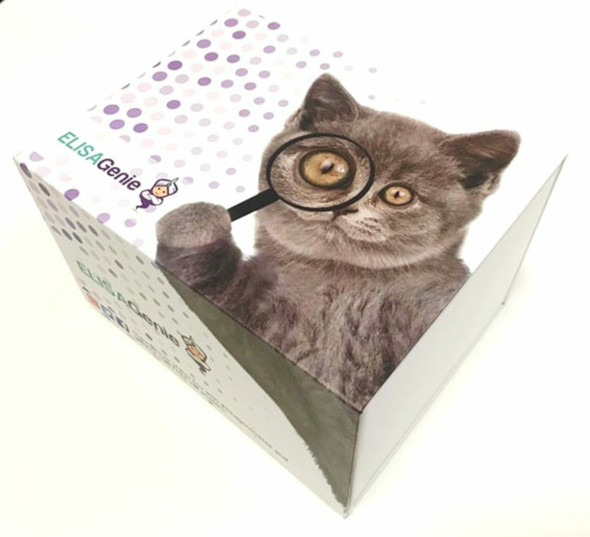Human Tyrosine-protein phosphatase non-receptor type 1 (PTPN1) ELISA Kit (HUEB1476)
- SKU:
- HUEB1476
- Product Type:
- ELISA Kit
- Size:
- 96 Assays
- Uniprot:
- P18031
- Range:
- 1.56-100 ng/mL
- ELISA Type:
- Sandwich
- Synonyms:
- PTP1B, PTPN1, Tyrosine-protein phosphatase non-receptor type 1
- Reactivity:
- Human
Description
Human Tyrosine-protein phosphatase non-receptor type 1 (PTPN1) ELISA Kit
The Human Tyrosine Protein Phosphatase Non-receptor Type 1 (PTPN1) ELISA Kit is a reliable tool for the quantitative measurement of PTPN1 levels in human serum, plasma, and cell culture supernatants. This kit offers high sensitivity and specificity, ensuring accurate and reproducible results for a variety of research applications.PTPN1 is a key enzyme involved in cellular signaling pathways, regulating processes such as cell growth, differentiation, and immune response.
Dysregulation of PTPN1 has been implicated in numerous diseases, including cancer, diabetes, and autoimmune disorders, making it a valuable target for studying disease mechanisms and developing potential interventions.By using the Human PTPN1 ELISA Kit, researchers can gain valuable insights into the role of PTPN1 in health and disease, leading to a better understanding of its potential as a therapeutic target.
| Product Name: | Human Tyrosine-protein phosphatase non-receptor type 1 (PTPN1) ELISA Kit |
| SKU: | HUEB1476 |
| Size: | 96T |
| Target: | Human Tyrosine-protein phosphatase non-receptor type 1 (PTPN1) |
| Synonyms: | Protein-tyrosine phosphatase 1B, PTP-1B, PTP1B |
| Assay Type: | Sandwich |
| Detection Method: | ELISA |
| Reactivity: | Human |
| Detection Range: | 1.56-100ng/mL |
| Sensitivity: | 0.056ng/mL |
| Intra CV: | 4.9% | ||||||||||||||||||||
| Inter CV: | 7.2% | ||||||||||||||||||||
| Linearity: |
| ||||||||||||||||||||
| Recovery: |
| ||||||||||||||||||||
| Function: | Tyrosine-protein phosphatase which acts as a regulator of endoplasmic reticulum unfolded protein response. Mediates dephosphorylation of EIF2AK3/PERK; inactivating the protein kinase activity of EIF2AK3/PERK. May play an important role in CKII- and p60c-src-induced signal transduction cascades. May regulate the EFNA5-EPHA3 signaling pathway which modulates cell reorganization and cell-cell repulsion. May also regulate the hepatocyte growth factor receptor signaling pathway through dephosphorylation of MET. |
| Uniprot: | P18031 |
| Sample Type: | Serum, plasma, tissue homogenates, cell culture supernates and other biological fluids |
| Specificity: | Natural and recombinant human Tyrosine-protein phosphatase non-receptor type 1 |
| Sub Unit: | Interacts with EPHA3 (phosphorylated); dephosphorylates EPHA3 and may regulate its trafficking and function. Interacts with MET. |
| Research Area: | Epigenetics |
| Subcellular Location: | Endoplasmic reticulum membrane Peripheral membrane protein Cytoplasmic side Interacts with EPHA3 at the cell membrane. |
| Storage: | Please see kit components below for exact storage details |
| Note: | For research use only |
| UniProt Protein Function: | PTP1B: a non-receptor phospho-tyrosine protein phosphatase which acts as a regulator of endoplasmic reticulum unfolded protein response. Mediates dephosphorylation and inactivation of PERK. May play an important role in CKII- and p60c-src-induced signal transduction cascades. May regulate the EFNA5-EPHA3 signaling pathway which modulates cell reorganization and cell-cell repulsion. Negatively regulates insulin signaling by dephosphorylating the phosphotyrosine residues of insulin receptor. Also reported to dephosphorylate integrin, epidermal growth factor receptor, JAK2 and TYK2, regulating cell growth control and the cellular response to interferon. May regulate the hepatocyte growth factor receptor signaling pathway through dephosphorylation of MET. PTP1B knockout mice show resistance to dietary weight gain and enhanced insulin sensitivity, suggesting a possible role in treatment of obesity as well as type 2 diabetes. |
| UniProt Protein Details: | Protein type:EC 3.1.3.48; Protein phosphatase, tyrosine (non-receptor); Motility/polarity/chemotaxis; Phosphatase Chromosomal Location of Human Ortholog: 20q13.1-q13.2 Cellular Component: endoplasmic reticulum; early endosome; plasma membrane; cytoplasmic vesicle; cytosol Molecular Function:protein binding; enzyme binding; ephrin receptor binding; zinc ion binding; protein tyrosine phosphatase activity; receptor tyrosine kinase binding; protein kinase binding; insulin receptor binding Biological Process: platelet activation; unfolded protein response, activation of signaling protein activity; negative regulation of vascular endothelial growth factor receptor signaling pathway; unfolded protein response; cytokine and chemokine mediated signaling pathway; actin cytoskeleton reorganization; regulation of endocytosis; insulin receptor signaling pathway; regulation of signal transduction; negative regulation of insulin receptor signaling pathway; blood coagulation Disease: Diabetes Mellitus, Noninsulin-dependent |
| NCBI Summary: | The protein encoded by this gene is the founding member of the protein tyrosine phosphatase (PTP) family, which was isolated and identified based on its enzymatic activity and amino acid sequence. PTPs catalyze the hydrolysis of the phosphate monoesters specifically on tyrosine residues. Members of the PTP family share a highly conserved catalytic motif, which is essential for the catalytic activity. PTPs are known to be signaling molecules that regulate a variety of cellular processes including cell growth, differentiation, mitotic cycle, and oncogenic transformation. This PTP has been shown to act as a negative regulator of insulin signaling by dephosphorylating the phosphotryosine residues of insulin receptor kinase. This PTP was also reported to dephosphorylate epidermal growth factor receptor kinase, as well as JAK2 and TYK2 kinases, which implicated the role of this PTP in cell growth control, and cell response to interferon stimulation. Two transcript variants encoding different isoforms have been found for this gene. [provided by RefSeq, Jul 2013] |
| UniProt Code: | P18031 |
| NCBI GenInfo Identifier: | 131467 |
| NCBI Gene ID: | 5770 |
| NCBI Accession: | P18031.1 |
| UniProt Secondary Accession: | P18031,Q5TGD8, Q9BQV9, Q9NQQ4, |
| UniProt Related Accession: | P18031 |
| Molecular Weight: | 49,967 Da |
| NCBI Full Name: | Tyrosine-protein phosphatase non-receptor type 1 |
| NCBI Synonym Full Names: | protein tyrosine phosphatase, non-receptor type 1 |
| NCBI Official Symbol: | PTPN1 |
| NCBI Official Synonym Symbols: | PTP1B |
| NCBI Protein Information: | tyrosine-protein phosphatase non-receptor type 1; protein-tyrosine phosphatase 1B; protein tyrosine phosphatase, placental |
| UniProt Protein Name: | Tyrosine-protein phosphatase non-receptor type 1 |
| UniProt Synonym Protein Names: | Protein-tyrosine phosphatase 1B; PTP-1B |
| Protein Family: | Tyrosine-protein phosphatase non-receptor |
| UniProt Gene Name: | PTPN1 |
| UniProt Entry Name: | PTN1_HUMAN |
| Component | Quantity (96 Assays) | Storage |
| ELISA Microplate (Dismountable) | 8×12 strips | -20°C |
| Lyophilized Standard | 2 | -20°C |
| Sample Diluent | 20ml | -20°C |
| Assay Diluent A | 10mL | -20°C |
| Assay Diluent B | 10mL | -20°C |
| Detection Reagent A | 120µL | -20°C |
| Detection Reagent B | 120µL | -20°C |
| Wash Buffer | 30mL | 4°C |
| Substrate | 10mL | 4°C |
| Stop Solution | 10mL | 4°C |
| Plate Sealer | 5 | - |
Other materials and equipment required:
- Microplate reader with 450 nm wavelength filter
- Multichannel Pipette, Pipette, microcentrifuge tubes and disposable pipette tips
- Incubator
- Deionized or distilled water
- Absorbent paper
- Buffer resevoir
*Note: The below protocol is a sample protocol. Protocols are specific to each batch/lot. For the correct instructions please follow the protocol included in your kit.
Allow all reagents to reach room temperature (Please do not dissolve the reagents at 37°C directly). All the reagents should be mixed thoroughly by gently swirling before pipetting. Avoid foaming. Keep appropriate numbers of strips for 1 experiment and remove extra strips from microtiter plate. Removed strips should be resealed and stored at -20°C until the kits expiry date. Prepare all reagents, working standards and samples as directed in the previous sections. Please predict the concentration before assaying. If values for these are not within the range of the standard curve, users must determine the optimal sample dilutions for their experiments. We recommend running all samples in duplicate.
| Step | |
| 1. | Add Sample: Add 100µL of Standard, Blank, or Sample per well. The blank well is added with Sample diluent. Solutions are added to the bottom of micro ELISA plate well, avoid inside wall touching and foaming as possible. Mix it gently. Cover the plate with sealer we provided. Incubate for 120 minutes at 37°C. |
| 2. | Remove the liquid from each well, don't wash. Add 100µL of Detection Reagent A working solution to each well. Cover with the Plate sealer. Gently tap the plate to ensure thorough mixing. Incubate for 1 hour at 37°C. Note: if Detection Reagent A appears cloudy warm to room temperature until solution is uniform. |
| 3. | Aspirate each well and wash, repeating the process three times. Wash by filling each well with Wash Buffer (approximately 400µL) (a squirt bottle, multi-channel pipette,manifold dispenser or automated washer are needed). Complete removal of liquid at each step is essential. After the last wash, completely remove remaining Wash Buffer by aspirating or decanting. Invert the plate and pat it against thick clean absorbent paper. |
| 4. | Add 100µL of Detection Reagent B working solution to each well. Cover with the Plate sealer. Incubate for 60 minutes at 37°C. |
| 5. | Repeat the wash process for five times as conducted in step 3. |
| 6. | Add 90µL of Substrate Solution to each well. Cover with a new Plate sealer and incubate for 10-20 minutes at 37°C. Protect the plate from light. The reaction time can be shortened or extended according to the actual color change, but this should not exceed more than 30 minutes. When apparent gradient appears in standard wells, user should terminatethe reaction. |
| 7. | Add 50µL of Stop Solution to each well. If color change does not appear uniform, gently tap the plate to ensure thorough mixing. |
| 8. | Determine the optical density (OD value) of each well at once, using a micro-plate reader set to 450 nm. User should open the micro-plate reader in advance, preheat the instrument, and set the testing parameters. |
| 9. | After experiment, store all reagents according to the specified storage temperature respectively until their expiry. |
When carrying out an ELISA assay it is important to prepare your samples in order to achieve the best possible results. Below we have a list of procedures for the preparation of samples for different sample types.
| Sample Type | Protocol |
| Serum | If using serum separator tubes, allow samples to clot for 30 minutes at room temperature. Centrifuge for 10 minutes at 1,000x g. Collect the serum fraction and assay promptly or aliquot and store the samples at -80°C. Avoid multiple freeze-thaw cycles. If serum separator tubes are not being used, allow samples to clot overnight at 2-8°C. Centrifuge for 10 minutes at 1,000x g. Remove serum and assay promptly or aliquot and store the samples at -80°C. Avoid multiple freeze-thaw cycles. |
| Plasma | Collect plasma using EDTA or heparin as an anticoagulant. Centrifuge samples at 4°C for 15 mins at 1000 × g within 30 mins of collection. Collect the plasma fraction and assay promptly or aliquot and store the samples at -80°C. Avoid multiple freeze-thaw cycles. Note: Over haemolysed samples are not suitable for use with this kit. |
| Urine & Cerebrospinal Fluid | Collect the urine (mid-stream) in a sterile container, centrifuge for 20 mins at 2000-3000 rpm. Remove supernatant and assay immediately. If any precipitation is detected, repeat the centrifugation step. A similar protocol can be used for cerebrospinal fluid. |
| Cell culture supernatant | Collect the cell culture media by pipette, followed by centrifugation at 4°C for 20 mins at 1500 rpm. Collect the clear supernatant and assay immediately. |
| Cell lysates | Solubilize cells in lysis buffer and allow to sit on ice for 30 minutes. Centrifuge tubes at 14,000 x g for 5 minutes to remove insoluble material. Aliquot the supernatant into a new tube and discard the remaining whole cell extract. Quantify total protein concentration using a total protein assay. Assay immediately or aliquot and store at ≤ -20 °C. |
| Tissue homogenates | The preparation of tissue homogenates will vary depending upon tissue type. Rinse tissue with 1X PBS to remove excess blood & homogenize in 20ml of 1X PBS (including protease inhibitors) and store overnight at ≤ -20°C. Two freeze-thaw cycles are required to break the cell membranes. To further disrupt the cell membranes you can sonicate the samples. Centrifuge homogenates for 5 mins at 5000xg. Remove the supernatant and assay immediately or aliquot and store at -20°C or -80°C. |
| Tissue lysates | Rinse tissue with PBS, cut into 1-2 mm pieces, and homogenize with a tissue homogenizer in PBS. Add an equal volume of RIPA buffer containing protease inhibitors and lyse tissues at room temperature for 30 minutes with gentle agitation. Centrifuge to remove debris. Quantify total protein concentration using a total protein assay. Assay immediately or aliquot and store at ≤ -20 °C. |
| Breast Milk | Collect milk samples and centrifuge at 10,000 x g for 60 min at 4°C. Aliquot the supernatant and assay. For long term use, store samples at -80°C. Minimize freeze/thaw cycles. |










